When using drones for travel photography, you'll need to navigate a complex web of regulations. Most countries require registration for drones over 250 grams and adherence to altitude limits, typically 400 feet. You must respect no-fly zones around airports, military bases, and populated areas. Privacy laws often prohibit filming people without consent. If you're selling your photos, you'll likely need commercial certification. Don't forget to check country-specific rules and consider drone insurance. Penalties for violations can be severe, ranging from fines to jail time. Understanding these laws is essential for safe and legal drone operation during your travels.
Understanding Drone Registration Requirements
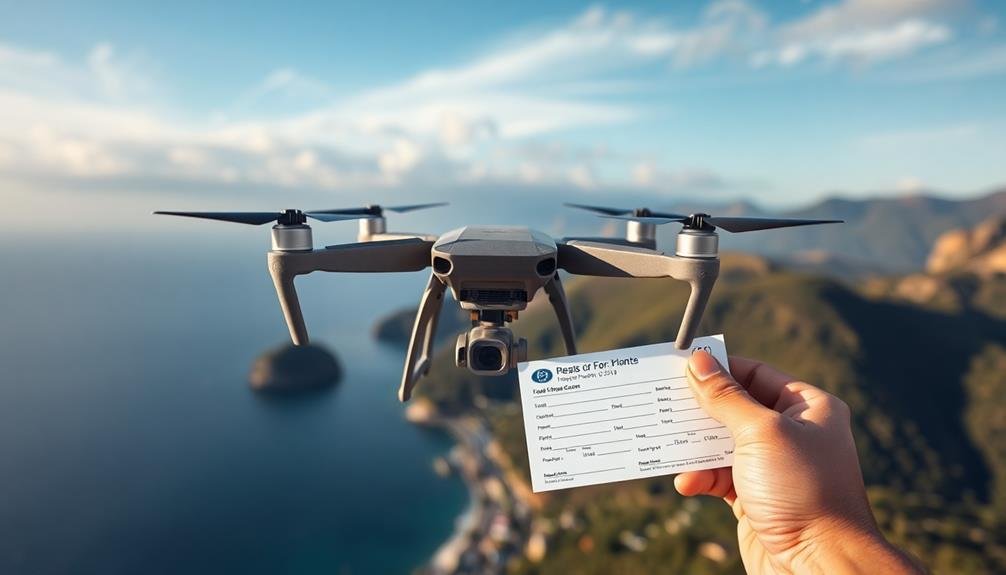
Before flying your drone for travel photography, it's crucial to understand the registration requirements. In many countries, you'll need to register your drone before operating it. The process typically involves providing personal information, drone specifications, and paying a fee.
In the United States, the Federal Aviation Administration (FAA) mandates registration for drones weighing over 0.55 pounds (250 grams). You'll receive a unique registration number to display on your drone.
The European Union has similar rules, with registration required for drones over 250 grams or equipped with cameras.
When traveling internationally, research each country's specific regulations. Some nations require temporary registration for visiting drone operators, while others may prohibit drone use entirely. You might need to obtain a permit or license in addition to registration.
Remember that registration requirements can change, so always check for updates before your trip. Failing to register your drone can result in hefty fines or legal consequences.
No-Fly Zones for Drones
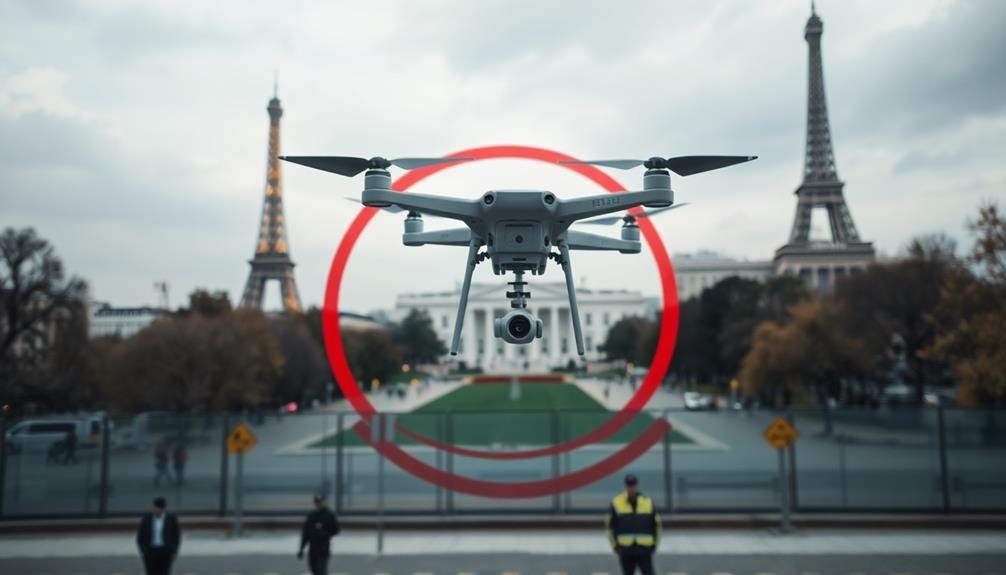
Frequently overlooked by novice drone photographers, no-fly zones are critical areas where drone operation is strictly prohibited. You'll need to familiarize yourself with these restricted areas before flying your drone for travel photography.
Common no-fly zones include airports, military bases, national parks, and government buildings. Many countries also restrict drone use near populated areas, historical sites, and critical infrastructure. You can't fly your drone within 5 miles of an airport without prior authorization, and you must always yield to manned aircraft.
To avoid legal troubles, use official apps or websites that provide up-to-date information on no-fly zones in your travel destination. The FAA's B4UFLY app is an excellent resource for U.S. locations, while other countries may have their own dedicated platforms.
Remember that no-fly zones can change, so check for updates regularly. Some areas may allow drone flights with special permits, but the application process can be lengthy.
If you're unsure about a location's drone restrictions, it's best to err on the side of caution and keep your drone grounded. Violating no-fly zones can result in hefty fines and legal consequences.
Altitude Restrictions for Aerial Photography
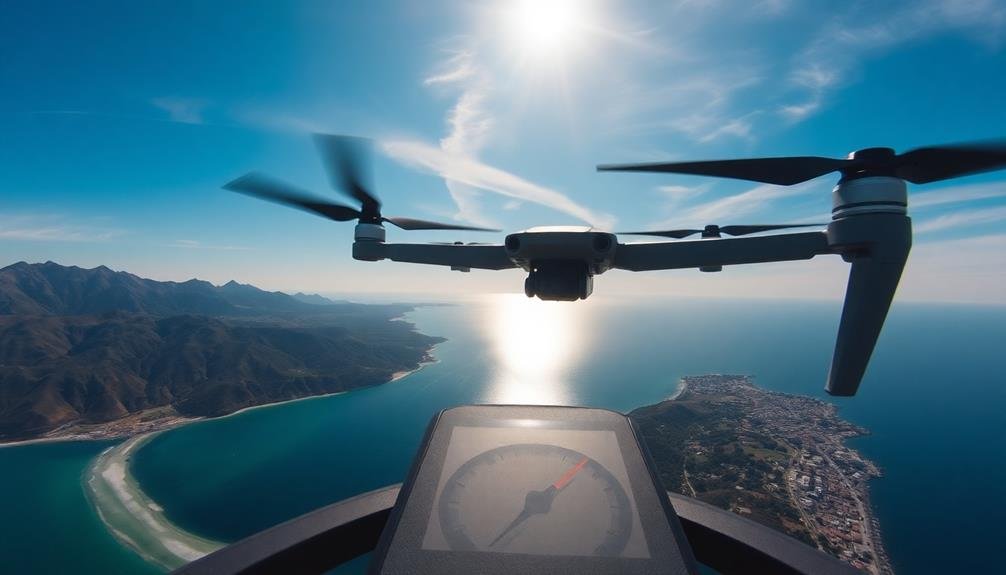
When capturing aerial photos with your drone, you must adhere to strict altitude restrictions. In most countries, the maximum allowed altitude for recreational drone flights is 400 feet (120 meters) above ground level. This limit helps prevent conflicts with manned aircraft and guarantees safer airspace for all.
Some locations may have lower altitude restrictions, especially near airports or in controlled airspace. You'll need to check local regulations and use drone apps to verify specific limits for your area. In certain cases, you might need to obtain special permission to fly higher for unique shots.
Remember that altitude limits apply to the drone's height above the takeoff point, not sea level. If you're flying from an elevated position, like a hilltop, factor this into your calculations.
Always maintain visual line of sight with your drone, which can become challenging at higher altitudes. Violating altitude restrictions can result in hefty fines and legal consequences.
It's essential to respect these limits, not only for compliance but also for the safety of others and the quality of your aerial photography. By following altitude rules, you'll capture stunning shots while flying responsibly.
Privacy Laws and Drone Usage
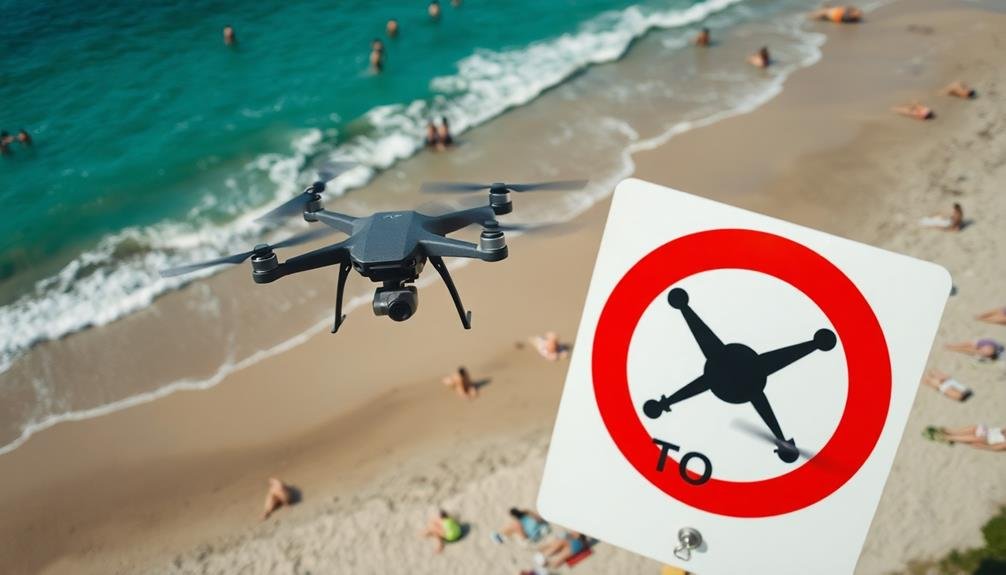
While altitude restrictions safeguard airspace, privacy laws protect individuals on the ground. As a travel photographer using drones, you must be aware of these regulations to avoid legal issues and respect people's privacy.
In many countries, it's illegal to capture images of people without their consent, especially in private spaces. You can't fly your drone over residential areas, backyards, or any place where people have a reasonable expectation of privacy. Some nations even prohibit drone photography of government buildings, military installations, and critical infrastructure.
To comply with privacy laws, always research local regulations before flying. In the US, for example, you must register your drone with the FAA and follow their guidelines. In the EU, the GDPR affects how you can collect and use personal data, including drone footage.
When capturing aerial shots, focus on landscapes and public spaces. If people are inadvertently included in your photos, consider blurring their faces or obtaining permission to use the images.
Commercial vs. Recreational Drone Rules
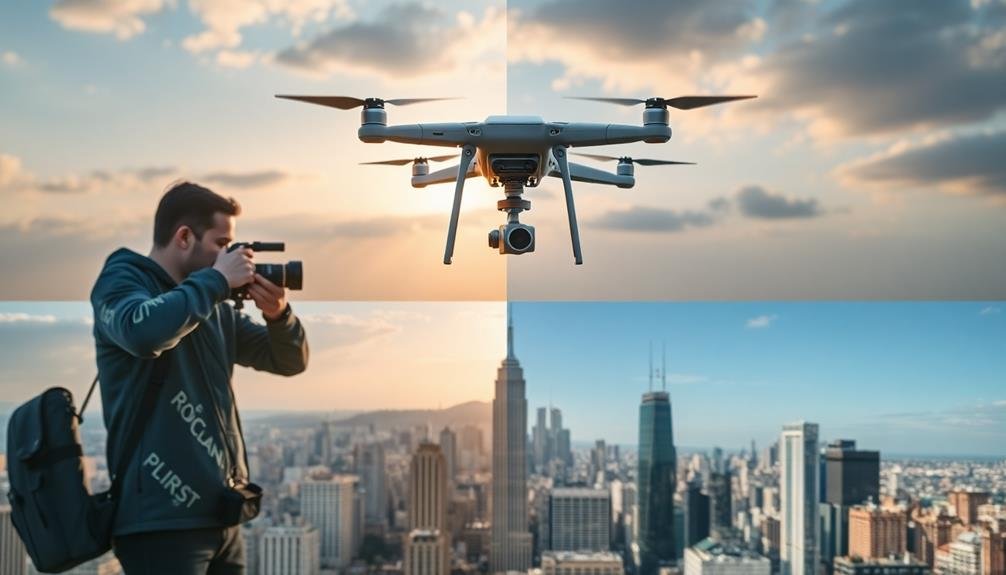
Although both commercial and recreational drone use are subject to regulations, the rules governing each category differ markedly.
As a travel photographer, you'll need to determine which category your drone usage falls under.
Recreational use typically involves flying for fun or personal enjoyment. If you're capturing images solely for your own memories or to share with friends and family, you're likely a recreational user. You'll need to follow basic safety guidelines, register your drone if it weighs over 0.55 pounds, and fly only in approved areas.
Commercial use, on the other hand, involves any drone operation that generates income or business benefits. If you're selling your travel photos, using them for marketing purposes, or incorporating them into paid content, you're considered a commercial operator. This classification requires additional steps, including obtaining a Remote Pilot Certificate from the FAA, registering your drone, and following stricter operational rules.
Be aware that the line between recreational and commercial use can blur, especially for travel photographers. If there's any chance your drone footage might be used commercially, it's safest to comply with commercial regulations to avoid potential legal issues.
Insurance Considerations for Drone Travel
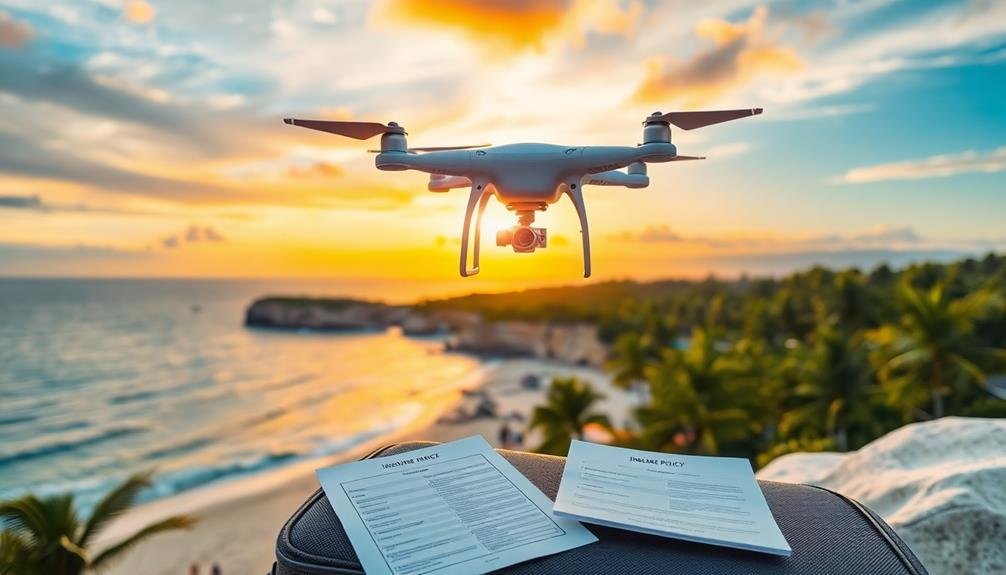
Drone insurance is a crucial consideration for travel photographers. When you're planning to take your drone abroad, you'll need to think about protecting your equipment and yourself from potential liabilities. Many standard travel insurance policies don't cover drones, so you'll likely need specialized coverage.
Before your trip, research drone-specific insurance options. These policies typically cover:
- Equipment damage or loss
- Third-party liability
- Personal injury
You'll find two main types of drone insurance: liability and hull insurance. Liability coverage protects you if your drone causes damage to property or injures someone. Hull insurance covers damage to your drone itself.
When traveling internationally, make certain your policy covers you in the countries you're visiting. Some insurers offer short-term or pay-as-you-fly options, which can be cost-effective for occasional travelers.
Don't forget to check if the countries you're visiting require proof of insurance for drone operations. Some nations mandate minimum liability coverage before you can legally fly.
Country-Specific Drone Regulations

When traveling with your drone, you'll need to research each country's specific regulations.
Popular tourist destinations often have varying rules, from outright bans to strict permit requirements.
Be sure to identify restricted zones and obtain necessary registrations or permits before flying your drone abroad.
Popular Tourist Destinations' Rules
Globetrotters enthusiastic to capture stunning aerial shots should be aware that drone regulations vary widely across popular tourist destinations. Some countries have strict no-fly zones, while others require permits or registration. It's essential to research and comply with local laws to avoid fines or confiscation of your equipment.
In Europe, you'll find diverse rules. For instance, Italy requires drone registration and insurance, while France prohibits drone use in urban areas without special authorization. The United Kingdom mandates a drone operator ID for most flights.
Popular Asian destinations also have specific regulations:
- Japan requires drone registration and restricts flights in densely populated areas.
- Thailand prohibits drone use near historical sites and royal palaces.
- Indonesia bans drones in national parks and around airports.
In the Americas, rules differ too. The United States requires registration for drones over 0.55 lbs, while Canada mandates a pilot certificate for most recreational flights. Mexico allows drones under 2 kg without registration but restricts flights near airports and government buildings.
Always check official sources for the most up-to-date information, as drone laws can change rapidly.
Restricted Zones Awareness
Understanding restricted zones is fundamental to responsible drone operation abroad. You'll find that many countries have specific areas where drone flights are strictly prohibited or heavily restricted. These often include military installations, government buildings, airports, and national parks. It's essential to research and identify these zones before your trip.
Many nations use smartphone apps or online maps to highlight no-fly zones. Download these tools for real-time information on restricted areas. In some countries, you'll need to maintain a certain distance from people, vehicles, and buildings. Be aware that these distances can vary considerably between jurisdictions.
Some locations may require special permits for drone use, even if you're not in a typically restricted area. Always check local regulations, as rules can change quickly. Remember that cultural sensitivities may also impact where you can fly, even if it's not legally restricted.
Violating restricted zone regulations can result in hefty fines, confiscation of your equipment, or even legal consequences. Stay informed, respect local laws, and prioritize safety to guarantee a smooth and enjoyable drone photography experience during your travels.
Registration and Permits
A maze of regulations awaits drone enthusiasts traveling abroad. You'll need to navigate country-specific drone laws, which often include registration and permit requirements. Before packing your drone, research the rules for each destination on your itinerary. Many countries mandate drone registration, even for short-term visitors.
To guarantee compliance, follow these steps:
- Check the local aviation authority's website for drone regulations.
- Register your drone online if required, often for a fee.
- Apply for any necessary permits well in advance of your trip.
Some nations, like Japan and Australia, have straightforward online registration processes. Others, such as India and Cuba, may require in-person registration or special permissions.
Be prepared to provide details about your drone, including its weight, model, and serial number. You might also need to show proof of insurance or pass a basic knowledge test.
Penalties for Violating Drone Laws
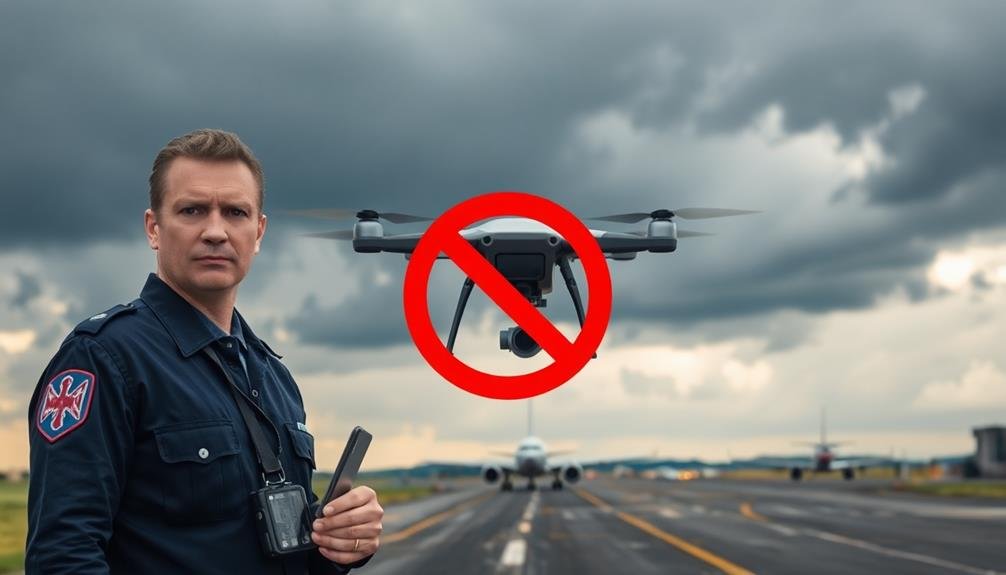
Depending on the severity of the infraction, penalties for violating drone laws can range from minor fines to hefty jail sentences.
You'll want to take these laws seriously, as even unintentional violations can result in significant consequences.
For minor infractions, like flying without proper registration or in restricted areas, you might face fines of a few hundred to several thousand dollars.
More severe violations, such as endangering aircraft or people, can lead to criminal charges, resulting in substantial fines and potential imprisonment.
In the US, the FAA can impose civil penalties up to $32,666 per violation for individuals and $163,333 for organizations.
Criminal penalties may include fines up to $250,000 and imprisonment for up to three years.
Internationally, penalties vary widely.
Some countries may confiscate your drone, while others impose steep fines or even arrest you.
In the UAE, for instance, flying a drone without proper permits can result in a $2,700 fine and up to three years in jail.
Drone Pilot Certification Requirements
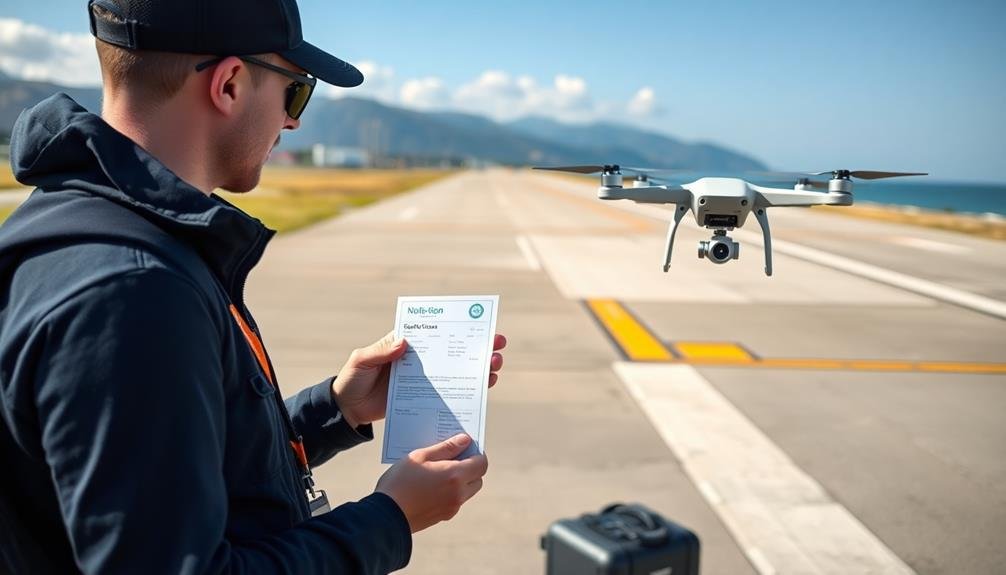
To avoid penalties and fly legally, you'll need to understand drone pilot certification requirements. In many countries, including the United States, you're required to obtain a license or certification before operating a drone for commercial purposes, which includes travel photography if you intend to sell or profit from your images.
For recreational use, certification requirements are often less stringent, but you'll still need to follow basic rules and regulations. In the U.S., you must pass The Recreational UAS Safety Test (TRUST) and carry proof of completion when flying.
For commercial drone operations, you'll typically need to:
- Pass a knowledge test covering airspace regulations, weather, and drone operations
- Register your drone with the appropriate aviation authority
- Obtain a Remote Pilot Certificate or equivalent license
Remember that certification requirements vary by country, so research the specific rules for your destination before traveling. Some nations may require you to obtain a temporary permit or register your drone upon arrival.
Always check for updates to drone laws, as regulations can change rapidly in this evolving field of technology.
Frequently Asked Questions
Can I Bring My Drone on a Plane?
You can bring your drone on a plane, but you'll need to follow specific airline guidelines. Pack it in your carry-on luggage, remove batteries, and check for any restrictions at your destination. Always declare it at security checkpoints.
How Do I Obtain Permission to Fly in Restricted Areas?
To fly in restricted areas, you'll need to contact the relevant authorities. It's often your local aviation agency or the specific site manager. Submit a formal request, detailing your plans, and be prepared for a thorough vetting process.
What Are the Rules for Flying Drones at Night?
You'll need special authorization for night flights. Get your Remote Pilot Certificate with a night flying endorsement, use anti-collision lights, and maintain visual line of sight. Always check local regulations as they may vary by location.
Are There Weight Limits for Drones Used in Travel Photography?
You'll find weight limits for travel photography drones vary by country. In the US, drones under 250 grams don't require registration. Heavier drones need registration and may face stricter rules. Always check local regulations before flying.
How Do I Handle Customs When Traveling Internationally With a Drone?
You'll need to declare your drone at customs. Check regulations for your destination country beforehand. Some may require permits or restrict drone use. Keep your drone in carry-on luggage and be prepared for possible inspection or fees.
In Summary
You've learned the key drone laws for travel photography. Remember to register your drone, respect no-fly zones and altitude limits, and protect people's privacy. Be aware of the differences between commercial and recreational rules, and consider insurance. Research country-specific regulations before you travel. Don't forget about certification requirements. By following these guidelines, you'll avoid penalties and enjoy safe, legal drone photography on your travels.

As educators and advocates for responsible drone use, we’re committed to sharing our knowledge and expertise with aspiring aerial photographers.




Leave a Reply